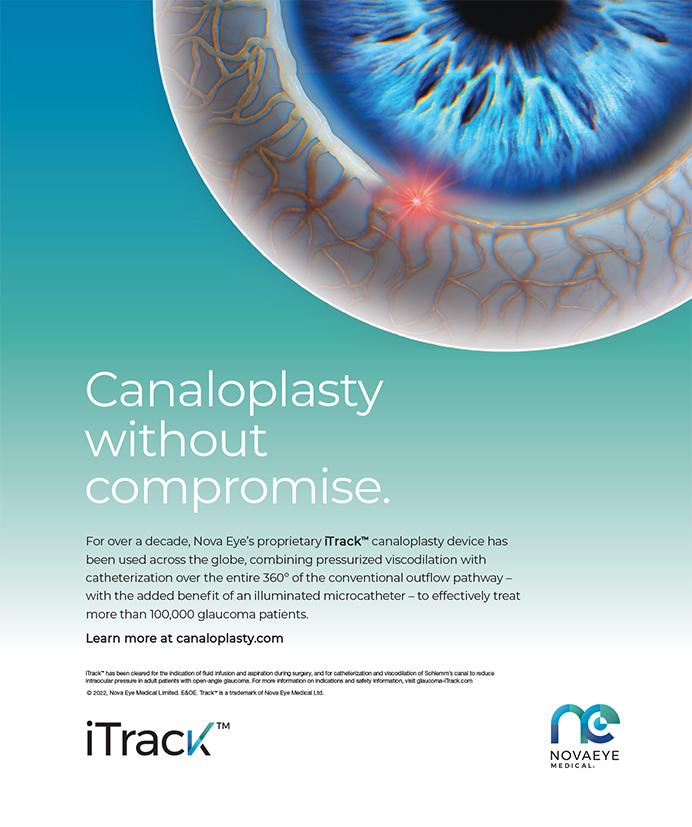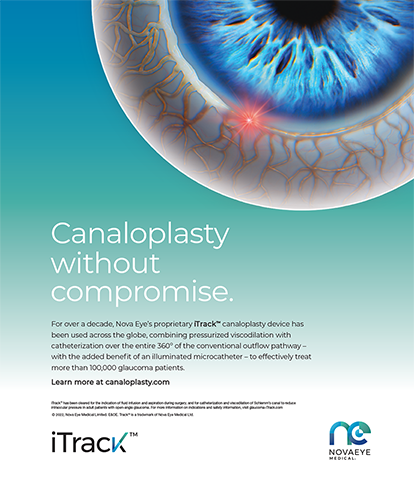Among the many benefits of performing surgical procedures with a femtosecond laser is that it offers surgeons a bladeless approach to treating patients. This installment of “Inside Eyetube.net” highlights videos that demonstrate the use of the femtosecond laser for corneal and cataract surgery. Also included are tips for positioning the patient's head before a procedure with a femtosecond laser and for removing thin cortical material afterward.
Bladeless SURGICAL Techniques
Georges D. Baikoff, MD, demonstrates keratoplasty procedures using the VisuMax femtosecond laser (Carl Zeiss Meditec, Inc.). He begins the video by providing instructions on how to organize the OR for daily use of the femtosecond laser for corneal and refractive procedures and how to maintain a sterile environment. Dr. Baikoff performs a variety of corneal surgeries with the laser, including penetrating keratoplasty with vertical (Figure 1) and oblique side cuts, deep anterior lamellar keratoplasty, re-dissection of a previously failed lamellar keratoplasty, thin anterior lamellar keratoplasty, and Descemet stripping endothelial keratoplasty. With each surgery, Dr. Baikoff describes how to use the femtosecond laser to prepare the donor graft and the recipient bed as well as how to prepare corneal tissue for implants and inlays.
T. Hunter Newsom, MD, demonstrates how he uses the IntraLase femtosecond laser (Abbott Medical Optics Inc.) to create clear corneal incisions for cataract surgery. In his video, Dr. Newsom provides a step-by-step description of how he performs this bladeless approach to cataract surgery, including preparing the patient, placing the suction ring, and planning the incisions. He also shares his surgical technique for making clear corneal incisions with the femtosecond laser. Once the incisions are complete, Dr. Newsom performs cataract surgery. He uses anterior segment optical coherence tomography to show how the laser creates clear, sharp, watertight corneal incisions that cannot be reproduced by hand (Figure 2).
Pavel Stodulka, MD, performs live refractive cataract surgery with the Victus Femtosecond Laser Platform (Bausch + Lomb; ; not available in the United States). He demonstrates how to prepare the patient, place the suction ring, and plan the corneal incisions, photodisruption, and the capsulorhexis. Dr. Stodulka highlights how the laser creates a circular cross-pattern to fragment the lens (Figure 3). Once the laser portion of the procedure is complete, Dr. Stodulka moves the patient to the Stellaris Vision Enhancement System (Bausch + Lomb) for phacoemulsification, and he finishes the surgery with the implantation of an aspheric hydrophobic IOL.
HELPFUL TIPS
In his video, A. John Kanellopoulos, MD, shares a pearl for how to tilt the patient's head during procedures with the WaveLight FS200 (Alcon Laboratories, Inc.). To broaden the actual field that the ascending cone of the patient interface will have with the patient's eye, Dr. Kanellopoulos recommends tilting the patient's head nasally. He says that this simple adjustment prevents the treatment cone from contacting the patient's nose and improves suction as well as the patient's comfort.
Ming Chen, MD, presents a technique for removing thin cortical material from the posterior capsule after fragmentation and phacoemulsification with the LenSx Laser (Alcon Laboratories, Inc.). Dr. Chen uses a polishing mold to hydrate and disengage the thin cortical material from the posterior capsule. Next, he uses a 90º I/A tip to carefully remove the material. This technique, he says, reduces the risk of damaging or tearing the capsule.CONCLUSION
These videos demonstrate how femtosecond lasers are useful and safe for the surgical settings described. As the use of femtosecond lasers for these procedures becomes more prevalent, many surgeons will have pearls to share with colleagues. Eyetube.net is an ideal forum for exhibiting valuable tips and tricks, and the author encourages readers to utilize this resource to the fullest.
Section Editor Elena Albé, MD, is a consultant in the Department of Ophthalmology, Cornea Service, Istituto Clinico Humanitas Ophthalmology Clinic, Milan, Italy. She acknowledged no financial interest in the products or companies mentioned herein. Dr. Albé may be reached at +39 0331 441721; elena.albe@gmail.com.
Section Editor Damien F. Goldberg, MD, is in private practice at Wolstan & Goldberg Eye Associates in Torrance, California.
Section Editor Mark Kontos, MD, is the senior partner at Empire Eye Physicians in Spokane, Washington.


